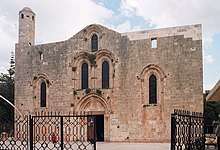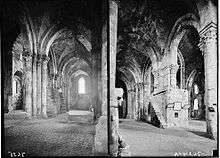Cathedral of Our Lady of Tortosa
Cathedral of Our Lady of Tortosa (Arabic: كاتدرائية طرطوس) was a Catholic cathedral in the city of Tartus, Syria, erected during the 12th century.[1] It has been described by historians as "the best-preserved religious structure of the crusades".[2]
| Cathedral of Our Lady of Tortosa كاتدرائية طرطوس | |
|---|---|
 | |
| Religion | |
| Affiliation | Catholic Church |
| Year consecrated | mid-12th century |
| Status | Museum |
| Location | |
| Location | Tartus, Syria |
| Geographic coordinates | 34°53′30″N 35°52′40″E |
| Architecture | |
| Style | Early Gothic, Romanesque |

According to a legend, the place corresponds to where Peter founded a small church.
After capture by the Mamluks, the cathedral was turned into a mosque. Today, the building serves as the National Museum of Tartus.
History
St. Peter, commissioned by Jesus Christ to build his Church (Matthew 16:18, John 21:15-17), founded a small church in Tortosa in honor of the Virgin Mary on his travels through Phoenicia (William of Tyre, Historia XXII, 3). The cathedral was erected on that site for Byzantine pilgrimages. It was built initially in Romanesque style and then gothic style during the 12th century.
From 1152 under mid-13th century, the Knights Templars governed the area. Since the town was repeatedly threatened by the Mamluks, the church building was fortified.
Tartus was allegedly the last holdings of the Knights Templars in the Near East. After capture, the cathedral was turned into a mosque. During the Ottoman period, the building was used as a stable. Since 1956, the prior church building has housed the National Museum of Tartus (the Tartus Museum),[3] which exhibits some archaeological objects.
References
- Carter, Dunston and Thomas, 2008, p.137.
- Setton, Zacour and Hazard, 1985, p.42-43.
- Abd al-Razzaq Moaz; et al. (2015). The Ayyubid Era: Art and Architecture in Medieval Syria. Museum with No Frontiers. p. 255. ISBN 978-3-902782-17-5.
Bibliography
- Boas, Adrian (1999), Crusader archaeology: the material culture of the Latin East, Routledge, ISBN 978-0-415-17361-2
- Carter, Terry; Dunston, Lara; Thomas, Amelia (2008), Syria & Lebanon, Lonely Planet, ISBN 978-1-74104-609-0
- Riley-Smith, Jonathan (2001), The Oxford Illustrated History of the Crusades, Oxford University Press, ISBN 978-0-19-285428-5
- Setton, Kenneth; Zacour, Norman; Hazard, Harry (1985), A History of the Crusades, Volume V: The Impact of the Crusades on the Near East, University of Wisconsin Press, ISBN 978-0-299-09144-6
- le Strange, Guy (1890). Palestine Under the Moslems: A Description of Syria and the Holy Land from A.D. 650 to 1500. Committee of the Palestine Exploration Fund.
- Paul Deschamps: Romanik im Heiligen Land, Würzburg 1992, S. 269–278.